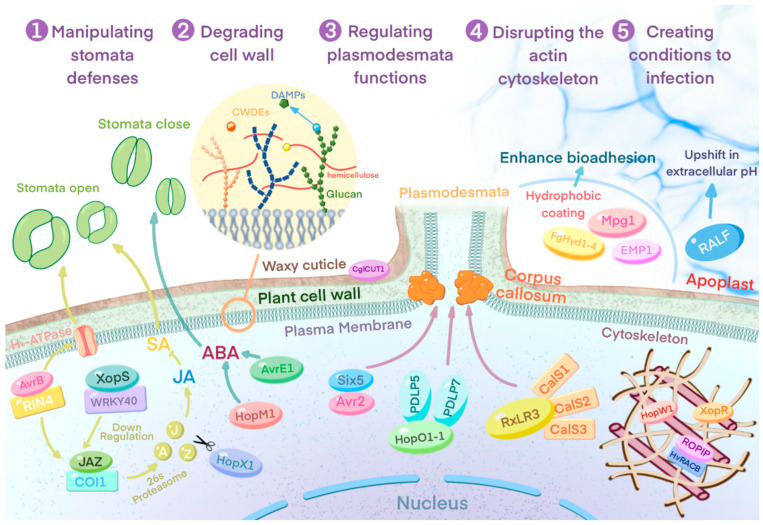Figure 2.
Schematic diagram of effectors that break physical barriers to infestation and regulate the infestation environment. Effectors promote infestation by regulating stomata, degrading cell walls, regulating intercellular filament function, disrupting the cytoskeleton, and creating conditions conducive to infestation. P. syringae AvrB interacts with RIN4 protein to promote COI1 and JAZ protein binding and enhance plasma membrane H+-ATPase AHA1 activity. HopX1 inhibits stomatal immunity by degrading multiple JAZ transcriptional repressors leading to JA activation. xopS stabilizes WRKY40 and decreases JAZ expression. HopM1 and AvrE1 target the ABA signaling pathway, increase ABA accumulation, and induce stomatal closure. Fusarium oxysporum Avr2 and Six5 interact with intercellular filaments to enlarge the pore size. The oomycete pathogen Phytophthora brassicae RxLR3 effector physically interacts with callus synthases CalS1, CalS2 and CalS3 to impede callus accumulation in intercellular hyphae. P. syringae HopO1-1 interacts with and destabilizes the PD proteins PDLP7 and PDLP5. HopW1 disrupts the actin cytoskeleton by forming complexes with actin. Bradyrhizobium graminearum ROPIP targets the barley ROP GTPase HvRACB and manipulates host cell microtubule organization to facilitate its own cell entry. Xanthomonas oleifera T3E XopR binds to actin in the cell cortex to manipulate actin assembly and disrupt the host actin cytoskeleton. The hydrophobic protein MPG1 in Fusarium inermis, FgHyd1~FgHyd4 in F. graminearum, and the extracellular matrix protein EMP1 in F. graminearum can create hydrophobic spaces and participate in appressorium development. Ralf-like effectors can cause an increase in extracellular pH to promote the invasive growth of the fungus. Overall, effectors favor their own infestation by modifying the structural properties of plant cells and environmental conditions.

